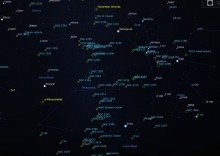With the clocks having just gone back, I thought I’d take a look at what there is to look forward to in the evening sky over the next couple of months.
The next full moon, on the 14th, will be one of those ‘supermoons’. It’ll be at it’s closest point to the Earth since 1948, and should appear around 14% larger than it does when at its furthest point. It won’t be this close again until November 2034!
As for planets, Venus is currently visible fairly low in the East at sunset (very bright indeed), and the red/orange orb of Mars is still very obvious in the South in the early evening. Both planets are an totally unmistakeable.
Uranus is very well placed at the moment, high in the South in Pisces. Neptune is currently a bit lower, in the Southwest in Aquarius, but is still a relatively easy find, and well worth a look. Compared to Jupiter and Saturn, the outer planets offer no visible detail, but the actual experience of observing solar system object at such great distances is amazing. To put them into perspective, something I try to do in my talks with Cubs and Scouts, if the Earth were the size of a cherry tomato, Uranus would be an apple 3.4km away, whilst Neptune would be a lime around 5km away!
Early risers can spot Jupiter rising in the East from about 4.30am. We won’t see it in the early evening sky until March of next year.
During November there are a couple of meteor showers to look out for: the Northern Taurids, and the November i-Aurigids, and, if you’re up late enough, the Leonids (probably the best of the bunch, and peaking at around 15 per hour on the 17th).
Next month there’s the Geminids (peaking mid December, and topping out at around 120 per hour!).
As for deep space objects, I guess the most imminent highlight has to be the return to the evening sky of Orion, and the great Orion Nebula. I actually had my first look at this at the weekend. It the seeing wasn’t great, and it appeared a little washed out, but it was very impressive, nonetheless.
To the left of Orion lie the constellations of Monoceros, Taurus, Auriga, Gemini and Cancer. There are literally dozens of open star clusters in these constellations (take a look at Monoceros in the accompanying picture), including Messiers 35, 36, 37, 38 and 44; all easy binocular objects, and well worth a look.
Castor in Gemini is a fantastic binary star system, and is very easy to find. Also in Gemini is the ‘Eskimo’ planetary nebula (so called because it’s said to resemble a person’s face surrounded by a ‘Parka’ type hood). You’ll need at least a small telescope to spot this one, but it’s well worth a look if you get the chance. Discovered by William Herschel in 1787, he described it thus:
“A star 9th magnitude with a pretty bright middle, nebulosity equally dispersed all around. A very remarkable phenomenon.“
From early December (or sooner if you’re up late enough!), Leo is rising in the East. Sighting this constellation signals, for me, the start of ‘galaxy season’. There are several to view in Leo, of course, but soon after Leo appears comes Virgo and Coma Berenices … both packed full of large, bright and easy to find galaxies.
Speaking of galaxies, as we swing into December, Ursa Major will be up on its ‘tail’, as it were, high in the North, and Canes Venatici will be swinging into view below and to the right. There are several fantastic galaxies to find in these constellations at this time of year (the Sunflower, Cocoon, Whale and Crowbar, for example).
So, weather permitting, there’s lot to see.
Clear skies!
Kevin Quinn is an amateur astronomer based in Cerne Abbas. He is the proud owner of a ten-inch reflector, a small refractor, a case of eyepieces, and a couple of pairs of binoculars. He tweets via @CerneAstro, and blogs (occasionally) via theastroguy.wordpress.com.
©Kevin Quinn












